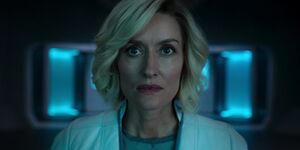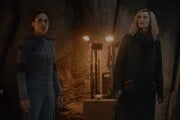Catherine Halsey/Silver: Difference between revisions
From Halopedia, the Halo wiki
Tag: Mobile edit |
SpartanLeet (talk | contribs) mNo edit summary |
||
| (One intermediate revision by one other user not shown) | |||
| Line 17: | Line 17: | ||
|height= | |height= | ||
|mass= | |mass= | ||
|hair= | |hair=Blonde | ||
|eyes= | |eyes= | ||
|affiliation=[[United Nations Space Command]] | |affiliation=[[United Nations Space Command]] | ||
| Line 54: | Line 54: | ||
{{Expand-section}} | {{Expand-section}} | ||
A brilliant but overly ambitious scientist, Catherine Halsey is devoted to the advancement of humanity, but will often use unethical means to achieve it, such as using and killing a live clone of herself to create [[Cortana/Silver|Cortana]], kidnapping and enlisting children against their will into the [[SPARTAN-II program/Silver|SPARTAN-II program]] before wiping their memories and subjecting them to horrific augmentations, and attempting to replace the human consciousness of the SPARTAN-II's with AI to make them "more controllable", as she attempted to do with [[John-117/Silver|John-117]] and Cortana. This eventually put her at odds with ONI, the UNSC, and even with her SPARTANs when they discovered the truth of their upbringing and her ultimate intentions. | A brilliant but overly ambitious scientist, Catherine Halsey is devoted to the advancement of humanity, but will often use unethical means to achieve it, such as using and killing a live clone of herself to create [[Cortana/Silver|Cortana]], kidnapping and enlisting children against their will into the [[SPARTAN-II program/Silver|SPARTAN-II program]] before wiping their memories and subjecting them to horrific augmentations, and attempting to replace the human consciousness of the SPARTAN-II's with AI to make them "more controllable", as she attempted to do with [[John-117/Silver|John-117]] and Cortana. This eventually put her at odds with ONI, the UNSC, and even with her SPARTANs when they discovered the truth of their upbringing and her ultimate intentions. | ||
Despite her seemingly cold and unfeeling exterior and tendency to see things through a purely scientific viewpoint, Halsey was not without affection, as she was devastated by Jacob Keyes' death on Reach and still cared deeply about the well-being of her daughter and the SPARTAN-II's. | |||
==Production notes== | ==Production notes== | ||
Latest revision as of 20:23, September 11, 2024
| This article contains information from the Silver Timeline universe, and is not a part of the established Halo canon. To see information about this article's counterpart in the canon Halo universe, see here |
| Catherine Halsey | |
|---|---|

| |
| Biographical information | |
|
Children: |
|
| Personal details | |
|
Species: |
|
|
Gender: |
Female |
|
Hair color: |
Blonde |
| Political and military information | |
|
Affiliation: |
|
|
Rank: |
Civilian scientist |
Doctor Catherine Elizabeth Halsey is a civilian scientist for the UNSC. She is the creator of the Spartan super soldiers, particularly the SPARTAN-II's.[1]
Biography[edit]
 This section needs expansion. You can help Halopedia by expanding it.
This section needs expansion. You can help Halopedia by expanding it.
Early life and career[edit]
Not much is known of Halsey's early life in the Silver timeline, but she had worked on the planet Onyx in her early days as a UNSC scientist. She later entered a romantic relationship with Jacob Keyes, with whom she had a daughter, Miranda, but due to her focus on her work as a UNSC scientist, Halsey's relationships with both Jacob and Miranda soured.
Finding John and the other SPARTAN candidates[edit]
Creating Cortana and dealing with a rogue Master Chief[edit]
Return to Eridanus II[edit]
At conflict with ONI, Chief and everyone[edit]
Desperate power grab attempt and escape[edit]
In ONI custody[edit]
Reunion with the deserter and the Fall of Reach[edit]
Coming to terms with John[edit]
Reunion with Miranda on Onyx and cracking Forerunner secrets[edit]
Infection by the Flood[edit]
Personality and traits[edit]
 This section needs expansion. You can help Halopedia by expanding it.
This section needs expansion. You can help Halopedia by expanding it.
A brilliant but overly ambitious scientist, Catherine Halsey is devoted to the advancement of humanity, but will often use unethical means to achieve it, such as using and killing a live clone of herself to create Cortana, kidnapping and enlisting children against their will into the SPARTAN-II program before wiping their memories and subjecting them to horrific augmentations, and attempting to replace the human consciousness of the SPARTAN-II's with AI to make them "more controllable", as she attempted to do with John-117 and Cortana. This eventually put her at odds with ONI, the UNSC, and even with her SPARTANs when they discovered the truth of their upbringing and her ultimate intentions.
Despite her seemingly cold and unfeeling exterior and tendency to see things through a purely scientific viewpoint, Halsey was not without affection, as she was devastated by Jacob Keyes' death on Reach and still cared deeply about the well-being of her daughter and the SPARTAN-II's.
Production notes[edit]
Catherine Halsey in Halo: The Television Series is portrayed by actress Natascha McElhone.[1] McElhone was originally cast to play both Halsey and Cortana, much like Jen Taylor did for Halo 4, Halo 5: Guardians, and Halo Infinite. However, due to scheduling difficulties caused by the COVID-19 pandemic, McElhone was unable to complete her work as Cortana, so Jen Taylor was brought onboard the project to reprise her role from the games.[2]
Gallery[edit]

|
Browse more images in this article's gallery page. |
Promotional image of Halsey for Halo: The Television Series Season One.
Promotional image of Halsey for Halo: The Television Series Season Two
List of appearances[edit]
- Halo: The Television Series Season One
- Contact (First appearance)
- Unbound
- Emergence
- Homecoming
- Reckoning
- Solace
- Allegiance
- Transcendence
- Halo: The Television Series Season Two
Sources[edit]
- ^ a b Entertainment Weekly, Halo TV series casts 2 actors to play familiar characters from game (Retrieved on Mar 19, 2022) [archive]
- ^ IGN, Halo TV Series Recasts Cortana With Original Voice Actress (Retrieved on Mar 19, 2022) [archive]



